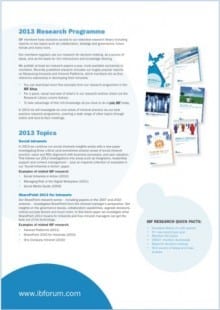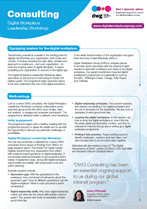5 essential skills we need now – for the digital workplaces to come

In our garden in the Cotswolds in England we have just built a studio.
If you stand in a particular spot, near the back wall, you can look across and see the stone walls, borders and porch at the entrance to our home. I remarked to my partner, Ali, that when the sun covered the 100-year-old garden the scene reminded me of stepping into a Monet painting.
Then, from that same position, but looking in the other direction, there is another view across the garden but flipped so that everything appears the opposite way round – this is the reflection of the garden, in a large mirror.
If you were shown these two views, could you decide which is the “real one” and which is the reflection? Unless you have visited us here, I suspect you can’t.
So, how does this relate to the digital worlds of work being created now and to those being sketched out in outline, which we will inhabit, navigate and spend large amounts of our working time within – in the 2020s?
This garden panorama – and the near impossibility of differentiating “real” from “fake”, for me points to some essential skills that we will all need to learn (and fast) to allow us calmly and powerfully to explore the new digital workplaces in the coming years.
The scene to the left (the reflection) will not only be just as convincing as the actual view soon enough, but if we were to “step” virtually into it, the sensation of being there would be equally compelling and feel natural. We will move between worlds that we call “real” and those that we call “digital” constantly and the lines that separate the two will blur. Our highly susceptible brains will struggle to see the differences.
So here are my 5 essential skills we need now – for the digital workplaces to come:
1. Feel as comfortable and at home in virtual worlds as we do in our “real” worlds
The debate around technology somehow encroaching on our non-tech selves and lives needs to be nudged into history and we need now to operate as naturally in the “invented worlds of work” as we do in the physical worlds. Just as we are all utterly at ease speaking on a phone or digital device to someone who is physically “not here” (where our voices have all the depth, richness and authenticity as if we were in the same room), so we need to learn to experience the virtual worlds of work that we “walk though” in the same way. Being at home in real-time digital workplaces of the 2020s will be a basic requirement.
This skill will allow us to make far more of the digital workplaces we will create and occupy. Instead of fighting against them, this capacity will enable a flow across time and space that will shatter our Industrial Age modes of separation.
2. Embrace intimacy in how we communicate in new digital workplaces
“Intimacy” might seem a strange term to describe the interactions in a digital world of work but we already have a texture, flow and connection with people in the physical world and this interaction quality needs to feature as the norm in digital workplaces. This idea came to mind for me after a visit to DWG member and client, IKEA, at their HQ in Sweden. They talk (in Sweden generally) of “fika”, which basically means chatting over cake and coffee with colleagues and friends. The quality of communication we require is a “digital fika”, to be experienced in the digital worlds in which we already spend so much time – with more to come.
Within my own organization, Digital Workplace Group, where I am CEO and Founder, closing down our physical offices five years ago actually created more digital intimacy across the company globally. This is achieved by using video and by knowing enough about each other to be aware of each others’ family, friends and interests, so that online interactions, whether real-time or asynchronous, are peppered with a quality of connection that is unusual in most organizations. This type of intimacy will be essential in the digital workplaces of the 2020s as most work will be done where colleagues are not physically present. It also helps to make work efficient from somewhere like with some companies using document management software to help maintain and protect documents.
3. Learning to work in the “open air”
This is about what has become known as “working out loud”, meaning that instead of keeping our work privately to ourselves within our own notes, documents and emails, etc., we become easy and proactive in sharing our work openly. I actually prefer the term “working openly” to “working out loud” as this style of work is neither noisy nor intrusive as the word “loud” suggests – it’s just open to others. Not every aspect of our work needs to be in the open but almost all of it may benefit.
What this can bring to our own work, as well as to that of our colleagues, is efficiency, speed and innovation. Simply sharing our diaries allows colleagues to use both their own time and ours better, by looking for and avoiding duplication, and spotting opportunities that might otherwise be hidden.
4. Build “digital strength” in how we work
Once the virtual worlds match our expectations of scale, accessibility and depth, we will need to use a digital dexterity to maximize their power. It is one thing to have fantastic digital workplaces, but if we are simply bystanders watching the data, intelligence and people pass us by, then where is the value for us? To exploit this opportunity requires an upgrading of our digital literacy and skills so that we know properly how to function in these (at first) strange, beautiful digital environments.
For example, logging into Workplace by Facebook or Office 365 today is fine and it’s a start. But until we can create shared documents, projects and knowledge in those spaces, we are like a person who has all the ingredients of a delicious meal but no idea how to cook. Digital strength and stamina must be built today so that we are ready.
5. Become adept at inhabiting a world beyond time and space
No, this is not Star Trek! Back to our studio: once we treat the reflected garden as “real” in a way that matches the physical garden, new possibilities appear. The “virtual garden” can be “sent” anywhere within the digital world in ways that are physically impossible for the real garden.
Today, our smartphones already calculate, connect and find information and people instantly – and we are relaxed about this facility. But what is actually happening is that within that small device we are treating space and time in new, remarkable, fluid ways.
For example, we can find an expert in a moment; render them holographically beside us; talk and exchange “digital fika” – rather than having to travel 12 hours to meet someone in a café in Mumbai.
So…
From a garden studio to a mirror image to the new-wave digital workplaces to come; we each need – as do our children – these 5 essential skills now, so that we can be of value as these new digital worlds of work arrive. What are we waiting for?
RESEARCH AND RESOURCES
- What is the “Digital IQ” of your leaders?
- FREE EXECUTIVE SUMMARY:The Inside-Out Digital Leader: Digitally transforming your organization from within
- FREE EXECUTIVE SUMMARY: Is your organization ready for the digital workplace?
- FREE EXECUTIVE SUMMARY: Becoming a Digital Workplace Leader
Take the next step
Improve your digital
leaders’ IQ
Categorised in: Digital workplace


